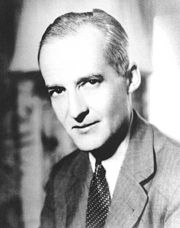Leloir
| Luis Federico Leloir | |
|---|---|

An early photograph of Leloir in his twenties
|
|
| Born |
September 6, 1906 Paris, France |
| Died | December 2, 1987 (aged 81) Buenos Aires, Argentina |
| Residence | Buenos Aires, Argentina |
| Nationality |
|
| Fields | Biochemistry |
| Institutions |
University of Buenos Aires Washington University in St. Louis (1943-1944) Columbia University (1944-1945) Fundación Instituto Campomar (1947-1981) University of Cambridge (1936-1943) |
| Alma mater | University of Buenos Aires |
| Known for |
Galactosemia Lactose intolerance Carbohydrate metabolism |
| Notable awards |
|
Luis Federico Leloir ForMemRS (September 6, 1906 – December 2, 1987) was an Argentine physician and biochemist who received the 1970 Nobel Prize in Chemistry. Although born in France, Leloir received the majority of his education at the University of Buenos Aires and was director of the private research group Fundación Instituto Campomar until his death in 1987. Although his laboratories were often plagued by lack of financial support and second-rate equipment, his research into sugar nucleotides, carbohydrate metabolism, and renal hypertension has garnered international attention and fame and has led to significant progress in understanding, diagnosing and treating the congenital disease galactosemia. Luis Leloir is buried in La Recoleta Cemetery, Buenos Aires.
Leloir's parents, Federico Leloir and Hortensia Aguirre de Leloir, traveled from Buenos Aires to Paris in the middle of 1906 with the intention of treating Federico's illness. However, Federico died in late August, and a week later Luis was born in an old house at 81 Víctor Hugo Road in Paris, a few blocks away from the Arc de Triomphe. After returning to Argentina in 1908, Leloir lived together with his eight siblings on their family's extensive property El Tuyú that his grandparents had purchased after their immigration from the Basque Country of northern Spain: El Tuyú comprises 400 km2 of sandy land along the coastline from San Clemente del Tuyú to Mar de Ajó which has since become a popular tourist attraction.
...
Wikipedia
